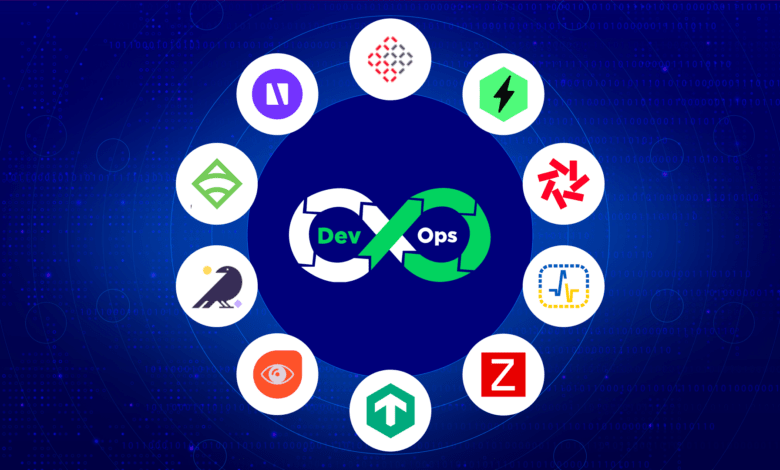DevOps Monitoring Tools for 2024

In this continuously developing age, where the latest applications and websites are released to users with trending features, traditional methods of testing and software development are not enough. DevOps bridges the gap between software development and IT operations, making it a one-stop solution for all the problems testing teams face.
This blog will provide 15 tools that can help you accelerate your software development, automation testing, and the whole software development cycle. Integrating these tools can make your automation testing and software development cycle more efficient.
What Is DevOps?
DevOps is an integrated approach to make software development and IT operations easier, focused on automation, continuous integration, and continuous development. It accelerates the software delivery process by breaking down team silos and encouraging a culture of continuous improvement.
Key practices include automating repetitive tasks, regularly incorporating code changes, automating deployment processes, treating infrastructure as code, implementing monitoring systems, promoting collaboration, advancing automation testing to the end of the development lifecycle, and encouraging continuous learning and improvement.
Organizations that embrace DevOps ideas and practices provide high-quality software more efficiently and consistently, allowing them to respond to the fast-changing demands in this continuous competitive era.
What is DevOps Monitoring?
DevOps monitoring constantly monitors and tests systems, applications, and servers to offer real-time information about performance, availability, and quality. It comprises metrics collection, logging, alerting, visualization, anomaly detection, performance monitoring, issue management, automation testing, and cloud testing tools.
The use of cloud testing tools is essential in DevOps monitoring. It is relevant for testers or testing teams to choose the correct cloud testing tools to improve the delivery of their website or application and satisfy the user experience.
Automation testing speeds up the software development cycles, allowing testers to skip the traditional manual way of testing websites and applications.
15 Trending DevOps Monitoring Tools for 2024
It is a significant task to choose the correct DevOps Monitoring tools, as these tools should provide all of the latest features that can help the testing team work efficiently and meet the demands of clients. Testing teams should keep up with trends to be ahead of their competitors.
Here are 15 amazing and trending DevOps Monitoring tools that will take your automation testing to the top:
1. Sensu
Sensu is a leading open-source monitoring system that provides lightweight agents for various contexts. Its features include an agent-based architecture for simple deployment, dynamic filtering, and tagging for customizable monitoring strategies. Sensu runs checks written in various languages, which trigger handlers for notifications or repairs.
It offers real-time analytics and visualizations via a web-based dashboard and easy integration with external systems for further functionality. Sensu’s scalability and fault tolerance offer great availability and dependability when monitoring large-scale, distributed systems. Overall, Sensu stands out due to its versatility, ease of use, and complete monitoring capabilities, making it an excellent choice for current IT systems.
2. Jenkins
Developers should choose Jenkins because of its wide plugin ecosystem, which allows for smooth interaction with various tools and technologies. Jenkins also allows developers to define pipelines like coding scripts to create version-controlled, repeatable workflows.
Jenkins distributed builds feature maximizes resource efficiency, while its user-friendly dashboard provides real-time information. With its vast security features and active community support, Jenkins helps developers accelerate development and automation testing, boost collaboration, and easily create high-quality software.
3. Librato
Librato is cloud-based monitoring software that stands out for its scalability, real-time analytics, and configurable visualization features. Its distinguishing features include easy integration with cloud services and rich metric labeling, which enables granular data organization.
Librato’s detection of bugs and predictive analytics assist in the early detection of difficulties, while its alerting system provides customizable notifications. Furthermore, the support for custom dashboards and chart comments improves data interpretation.
4. PagerDuty
PagerDuty is an incident management software popular for its reliable alerting and on-call scheduling capabilities. Its unique features include customized escalation methods, which allow teams to design hierarchical response pathways based on intensity and urgency.
PagerDuty’s extensive connections with monitoring tools, collaboration platforms, and ticketing systems simplify incident response processes.
Its real-time issue status updates and automatic notifications facilitate speedy incident response. PagerDuty’s analytics and reporting features provide valuable insights into event trends and team performance, helping businesses enhance incident response strategies and improve operational efficiency.
5. Kibana
Its unique characteristics include interactive visualizations, such as histograms, pie charts, and heat maps, that make it simple to view and evaluate massive data sets. Kibana has extensive search features, allowing quick and easy real-time data querying and filtering. Users can use the dashboard tool to construct customized dashboards to monitor critical data and key performance metrics.
Kibana offers capabilities for evaluating geographic data through mapping and visualization, making it a versatile solution for investigating and comprehending data in various settings.
6. Prometheus
Prometheus is an open-source monitoring and alerting solution that prioritizes dependability and scalability in modern, dynamic situations. It captures time series data via a pull approach over HTTP, allowing for flexible monitoring of multiple systems and services. With its multidimensional data model and strong query language (PromQL), users can gain full insight into the performance and general condition of their infrastructure.
Prometheus provides extensive support for service discovery, enabling the automatic detection of targets such as containers, virtual machines, and cloud services. It supports rich instrumentation, exposing developers to unique metrics for monitoring their applications.
7. Nagios
Nagios is well-known for its strong monitoring capabilities, which include several unique features. Its flexibility allows users to create custom plugins to monitor any device, service, or application. Nagios offers extensive alerting capabilities that enable various notification systems such as email, SMS, and custom scripts, ensuring quick response to concerns.
Nagios’ complex scheduling and escalation procedures ensure that alerts are effectively managed and responsibilities are correctly assigned. Its online interface provides administrators with real-time status updates and reporting, allowing them to understand the system’s health and performance better. Nagios has a large and active user community that promotes continuing development and support.
8. Grafana
Grafana is a flexible open-source platform with a user-friendly interface and intuitive capabilities. It supports various data types, including time series databases, logs, and metrics stores, allowing users to aggregate and analyze data from several sources quickly.
Grafana’s highly customized dashboards enable live and interactive data visualization, allowing for in-depth system performance and trends analysis. Grafana’s easy querying and alerting capabilities help users quickly monitor and respond to important occurrences.
9. Akamai mPulse
Akamai mPulse is a complete real-user monitoring (RUM) solution with enhanced features to improve online speed and user experience. It delivers detailed insights into website and application performance by continuously monitoring real-time user interactions.
Customizable dashboards allow users to visualize performance indicators and user behavior, while anomaly detection capabilities help uncover issues early on. mPulse also includes segmentation capabilities for analyzing performance across different user groups and devices and integrations with other Akamai technologies for complete web performance optimization.
It also offers actionable ideas for boosting performance and increasing customer satisfaction.
10. New Relic One
New Relic One is a powerful monitoring platform that provides detailed information about the performance and health of today’s software. The application provides a comprehensive view of infrastructure and user experience data, allowing users to monitor, diagnose, and improve their environments.
New Relic One features include variable monitoring, vulnerability detection, and customizable control panels. These allow teams to quickly find and resolve issues, increase applications’ operational efficiency, and improve end users.
11. Tasktop Integration Hub
Tasktop Integration Hub is a powerful integration platform that simplifies and automates software delivery operations across several tools and platforms. Its primary features include a diverse set of pre-built connectors for prominent ALM, DevOps, and ITSM applications, allowing for smooth data synchronization and workflow orchestration.
Integration Hub enables bidirectional data flow, allowing teams to interact efficiently while maintaining consistency across tools. Its customized mapping and transformation capabilities enable data normalization and modification to fit specific business needs. Integration Hub also enables visibility and traceability throughout the automation testing and software delivery lifecycle, improving collaboration and decision-making.
12. The Datical Deployment Monitoring Console
The Datical Deployment Monitoring Console includes tools to provide complete visibility and control over database deployment procedures. Real-time monitoring of deployment progress enables users to track changes and detect concerns as they arise.
The portal provides precise insights into deployment performance indicators and compliance status, guaranteeing compliance with business standards and regulations. It provides customized dashboards and reporting tools, allowing customers to personalize views to their needs.
It also includes alerting capabilities that warn stakeholders of crucial occurrences, allowing for more proactive management of database installations for increased efficiency and reliability.
13. Middleware
Middleware connects multiple software programs, allowing for easy communication and integration. Message queueing for asynchronous communication is a key component for efficient and scalable data transfer between systems. Middleware frequently provides transaction management features, which ensure data consistency and reliability across distributed settings.
It includes security measures such as authentication and encryption to safeguard sensitive information during transmission. Middleware also supports protocol translation, which enables interchange between systems that use multiple communication protocols. Its monitoring and management tools provide visibility into system health and performance, allowing for efficient troubleshooting and optimization of middleware-based designs.
14. Datadog
Datadog uniquely combines infrastructure monitoring, application performance monitoring, and access control into a single platform. It can interact with the ability to resolve conflicts, while features like distributed monitoring and APM provide insight into application performance in a single round, increasing optimization and confidence.
15. Splunk
Splunk is a popular tool for monitoring applications. It helps you see what’s happening with your apps in real time, especially when you publish them quickly to users.
With Splunk, you can monitor your apps throughout their entire journey, from when they’re just an idea to when they’re up and running for users. This helps you ensure that your apps work well and have a big impact on your business while being made and delivered faster.
Bonus Tool: Selenium
Selenium is a prevalent open-source test automation framework embraced within the DevOps methodology. As an open-source solution, Selenium empowers teams to automate test executions seamlessly and continuously across the software development lifecycle. Although Selenium tests conventionally run on local environments, cloud platforms like LambdaTest offer a scalable and user-friendly alternative for executing Selenium tests in a distributed fashion across diverse browsers and operating systems.
LambdaTest is an AI-powered test orchestration and execution platform for running manual and automated tests at scale. The platform allows you to perform real-time and automation testing across 3000+ environments and real mobile devices.
Conclusion
In summary, the 2024 DevOps landscape will be characterized by various new assessment tools designed to improve the software development process, collaboration, and work.
By applying DevOps, teams can reduce delivery cycles, improve software quality, and respond to changing digital needs by incorporating these tools. Implementing DevOps in automation testing and using innovative DevOps monitoring tools helps firms to remain competitive, provide greater customer experiences, and succeed in an era of intense competition.




